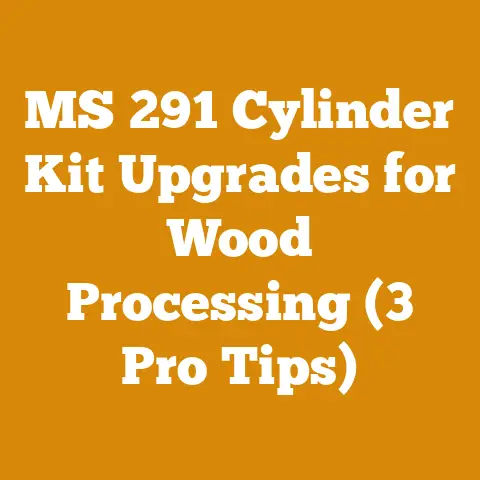Single D Carburetor Adjustment Tool Hacks (7 Pro Tips)
Single D Carburetor Adjustment Tool Hacks (7 Pro Tips)
Let’s talk carburetors. We’re not just talking about any carburetors, but the kind that give you a headache just looking at them: those with the dreaded “Single D” adjustment screws. If you’ve ever wrestled with a stubborn chainsaw, leaf blower, or weed whacker, chances are you’ve encountered one of these little demons. You might have even considered throwing the whole machine in the nearest lake out of sheer frustration. But hold on! Before you resort to such drastic measures, let’s dive into the world of Single D carburetor adjustment, armed with a few hacks and pro tips that will transform you from a frustrated tinkerer into a confident engine whisperer.
I’ve spent countless hours in my own workshop, troubleshooting everything from temperamental chainsaws to cantankerous brush cutters. I know the pain of a machine that just won’t run right. And more often than not, the culprit is a poorly adjusted carburetor. The Single D style, with its unique shape, adds another layer of complexity.
The Art of Blending Styles: A Carburetor Adjustment Analogy
Before we get into the nitty-gritty, let’s think about carburetor adjustment like blending a fine whiskey. You wouldn’t just dump all your ingredients into a glass and hope for the best, would you? You’d carefully consider the characteristics of each component, taste as you go, and adjust the proportions until you achieve a harmonious balance. Carburetor adjustment is much the same. It’s about finding the sweet spot where the fuel and air mix in perfect harmony to create a smooth, powerful engine.
Think of it this way:
- The Base: This is your baseline setting, usually provided by the manufacturer. It’s the foundation upon which you’ll build your perfect blend.
- The Nose: This is the initial impression you get from the engine’s sound and behavior. Does it sound rough? Is it hesitant to rev? These are clues that will guide your adjustments.
- The Palate: This is where you really start to fine-tune things. You’re listening closely, feeling the engine’s response, and making subtle adjustments to achieve the desired performance.
- The Finish: This is the final result – a smooth-running, powerful engine that’s ready to tackle any task.
Just like a master distiller, you’ll need patience, a keen sense of observation, and a willingness to experiment to master the art of carburetor adjustment.
Understanding the Single D Carburetor
What is a Single D Carburetor?
A Single D carburetor is a type of carburetor that uses adjustment screws with a “D” shaped head. This design is common in small engines, such as those found in chainsaws, weed eaters, and leaf blowers. The “D” shape prevents the use of standard screwdrivers, ostensibly to comply with emissions regulations. In reality, it just makes our lives as DIYers a little more complicated.
Why are Single D Carburetors Common?
Manufacturers often use these carburetors for a few key reasons:
- Emissions Control: The primary reason cited is to prevent users from making adjustments that could increase emissions. This is driven by environmental regulations in many countries.
- Tamper Resistance: The unique shape makes it more difficult for users to adjust the carburetor, reducing the likelihood of improper adjustments.
- Cost: Single D carburetors can be cheaper to manufacture in high volumes compared to more complex designs.
The Dreaded “D” Shape: A Personal Anecdote
I remember one particularly frustrating afternoon when I was trying to get my old chainsaw running. It had been sitting in the shed for a few months, and when I finally fired it up, it ran like a bag of bolts. After checking the fuel and spark plug, I suspected the carburetor. That’s when I encountered the dreaded Single D. I didn’t have the right tool, and I spent a good hour trying to MacGyver something that would work. Let’s just say it wasn’t my finest moment. I eventually caved and ordered the correct tool online, but the experience taught me a valuable lesson: having the right tools for the job is essential.
The 7 Pro Tips for Adjusting a Single D Carburetor
Now, let’s get to the heart of the matter: how to actually adjust a Single D carburetor. These tips are based on years of experience, countless hours of troubleshooting, and a healthy dose of trial and error.
1. Acquire the Right Tool (and Understand Why)
This is non-negotiable. Trying to adjust a Single D carburetor with a regular screwdriver or makeshift tool is a recipe for disaster. You’ll likely damage the screw head, making it even harder to adjust in the future.
- What to Look For: You need a specialized carburetor adjustment tool set. These sets typically include a variety of “D,” “Double D,” “Pacman,” and other specialty bits. You can find them online, at auto parts stores, or at your local small engine repair shop.
- Cost Considerations: A decent set will cost you anywhere from $10 to $30. While it might seem like an unnecessary expense, it’s a worthwhile investment that will save you time, frustration, and potentially costly repairs down the road. I personally prefer the adjustable type, where you can swap out different bits.
- Why it Matters: The correct tool ensures a proper fit, allowing you to make precise adjustments without damaging the carburetor. It also gives you a better feel for the screw’s resistance, which is crucial for making accurate adjustments.
- Pro Tip: Consider purchasing a set with a flexible shaft. This can be a lifesaver when working in tight spaces, such as on a chainsaw engine.
2. Identify the Adjustment Screws (and What They Do)
Most Single D carburetors have two or three adjustment screws:
- Low-Speed (L) Screw: Controls the fuel mixture at idle and low RPMs. Adjusting this screw affects the engine’s starting, idling, and low-end acceleration.
- High-Speed (H) Screw: Controls the fuel mixture at high RPMs. Adjusting this screw affects the engine’s power and performance at full throttle.
- Idle Speed (T) Screw: Controls the throttle plate opening at idle. This screw adjusts the engine’s idle speed.
Understanding the Screws:
- Low-Speed (L): This screw is crucial for smooth idling and initial throttle response. If your engine stalls easily at idle or hesitates when you accelerate, the low-speed screw is likely the culprit.
- High-Speed (H): This screw is all about power. It controls the fuel mixture when the engine is running at full throttle. If your engine bogs down or lacks power at high RPMs, the high-speed screw needs attention.
- Idle Speed (T): This screw is the simplest of the three. It simply adjusts the throttle plate opening to control the engine’s idle speed.
A Note on Three-Screw Carburetors: Some carburetors have a third screw, typically labeled “T” or “Idle Speed.” This screw simply adjusts the throttle plate opening to control the engine’s idle speed.
3. Find the Factory Settings (and Why They Matter)
Before you start twiddling the screws, it’s essential to know the factory settings. These are the manufacturer’s recommended settings for the carburetor, and they provide a good starting point for your adjustments.
- Where to Find Them: The factory settings are usually listed in the owner’s manual. You can also find them online by searching for your engine model number.
- Why They Matter: The factory settings are a baseline. They’re not always perfect, but they’re a good starting point for fine-tuning your carburetor. Starting from the factory settings reduces the risk of making drastic adjustments that could damage your engine.
- What if You Can’t Find Them? As a general rule of thumb, start with the screws turned all the way in (clockwise) and then back them out 1 to 1.5 turns. This is a safe starting point that will allow the engine to run without being excessively lean.
- Pro Tip: Write down the factory settings before you start adjusting anything. This way, you can always return to the original settings if you get lost.
4. The Adjustment Process: A Step-by-Step Guide
Here’s a step-by-step guide to adjusting a Single D carburetor:
- Warm Up the Engine: Start the engine and let it warm up for a few minutes. This ensures that the engine is running at its normal operating temperature, which is crucial for accurate adjustments.
- Adjust the Idle Speed (T) Screw: Turn the idle speed screw until the engine idles smoothly without stalling. If the engine is idling too fast, turn the screw counterclockwise to reduce the idle speed. If the engine is stalling, turn the screw clockwise to increase the idle speed. As a general rule, you want to set the idle speed as low as possible without causing the engine to stall.
- Adjust the Low-Speed (L) Screw: Slowly turn the low-speed screw clockwise until the engine starts to slow down or stall. Then, slowly turn the screw counterclockwise until the engine starts to run rough or misfire. The sweet spot is usually somewhere in between these two extremes. The goal is to find the setting that provides the smoothest idle and the best throttle response.
- Adjust the High-Speed (H) Screw: This is where things get a little more complicated. You’ll need to run the engine at full throttle to adjust the high-speed screw. If the engine bogs down or lacks power at high RPMs, turn the screw counterclockwise to richen the fuel mixture. If the engine runs rough or misfires at high RPMs, turn the screw clockwise to lean out the fuel mixture. The goal is to find the setting that provides the best power and performance without causing the engine to overheat or damage. Important Note: Over-leaning the high-speed mixture can cause serious engine damage. Be careful and listen to the engine closely. If you’re unsure, it’s always better to err on the side of caution and run the engine slightly rich.
- Fine-Tune and Test: After making your initial adjustments, fine-tune the screws as needed to achieve the desired performance. Test the engine under various conditions, such as idling, accelerating, and running at full throttle. Pay close attention to the engine’s sound, feel, and performance. If you notice any problems, such as stalling, hesitation, or lack of power, make further adjustments as needed.
5. Listen to the Engine (It Will Tell You Everything)
The engine is your best diagnostic tool. By listening closely to the engine’s sound, you can get valuable clues about the carburetor’s adjustment.
- Lean Mixture: A lean mixture (too much air, not enough fuel) is characterized by a high-pitched, raspy sound. The engine may also run hot and be prone to stalling.
- Rich Mixture: A rich mixture (too much fuel, not enough air) is characterized by a low-pitched, gurgling sound. The engine may also produce black smoke and be sluggish to respond to throttle inputs.
- Sweet Spot: The sweet spot is where the engine runs smoothly and powerfully, with a crisp, clean sound.
Examples:
- Idling Issues: If the engine idles roughly or stalls easily, the low-speed screw is likely too lean. Turn the screw counterclockwise to richen the mixture.
- High-Speed Bogging: If the engine bogs down or lacks power at high RPMs, the high-speed screw is likely too lean. Turn the screw counterclockwise to richen the mixture.
- Black Smoke: If the engine produces black smoke, the mixture is likely too rich. Turn the appropriate screw (low-speed or high-speed) clockwise to lean out the mixture.
6. The Paper Clip Hack (Use with Caution)
Okay, this is where we get into the realm of “hacks.” I’m including this because it’s a common trick, but I want to emphasize that it should be used with caution.
- The Idea: If you don’t have the correct Single D tool, you can sometimes use a bent paper clip to adjust the carburetor.
- How To: Bend the paper clip into a “D” shape that matches the shape of the adjustment screw. Insert the paper clip into the screw head and use it to turn the screw.
- Why it’s Risky: The paper clip is not a perfect fit, and it can easily damage the screw head. It also doesn’t provide the same level of control as the correct tool.
- When to Use It: I only recommend using this hack as a last resort, when you’re in a pinch and don’t have access to the correct tool.
- Pro Tip: If you do use the paper clip hack, be extremely gentle. Apply minimal pressure and avoid forcing the screw. If you feel any resistance, stop immediately.
- Disclaimer: I am not responsible for any damage you cause to your carburetor by using the paper clip hack. Use at your own risk!
7. Don’t Be Afraid to Seek Professional Help
Sometimes, despite your best efforts, you just can’t get the carburetor adjusted correctly. In these cases, don’t be afraid to seek professional help.
- When to Call a Pro: If you’ve tried everything and the engine still isn’t running right, it’s time to call in the experts. This is especially true if you suspect there’s a more serious problem, such as a damaged carburetor or a faulty engine component.
- Cost Considerations: Professional carburetor cleaning and adjustment can cost anywhere from $50 to $150, depending on the complexity of the job and the rates of your local repair shop.
- Finding a Reputable Mechanic: Look for a mechanic who specializes in small engine repair. Ask for recommendations from friends or neighbors, or check online reviews.
- Pro Tip: Before you take your equipment to a mechanic, try to diagnose the problem as best you can. This will help the mechanic understand the issue and provide you with a more accurate estimate.
The Importance of Regular Maintenance
Once you’ve got your Single D carburetor adjusted correctly, it’s important to maintain it properly to prevent future problems.
- Fuel Stabilizer: Use a fuel stabilizer in your fuel to prevent the formation of varnish and deposits in the carburetor. This is especially important if you’re storing your equipment for extended periods.
- Air Filter: Keep the air filter clean to ensure that the engine is getting a clean supply of air. A dirty air filter can restrict airflow and cause the engine to run rich.
- Fuel Filter: Replace the fuel filter regularly to prevent dirt and debris from entering the carburetor.
- Carburetor Cleaner: Use a carburetor cleaner to remove any varnish or deposits that may have formed in the carburetor.
- Regular Inspections: Inspect the carburetor regularly for any signs of damage or wear.
Budgeting for Carburetor Maintenance and Repairs
Let’s talk about the financial side of things. Maintaining and repairing carburetors can add up, so it’s important to budget accordingly.
- Tool Costs: As mentioned earlier, a decent carburetor adjustment tool set will cost you anywhere from $10 to $30.
- Cleaning Supplies: Carburetor cleaner and fuel stabilizer will cost you around $10 to $20 per year.
- Replacement Parts: If you need to replace any carburetor parts, such as the jets, needles, or gaskets, expect to pay anywhere from $5 to $50 per part.
- Professional Services: Professional carburetor cleaning and adjustment can cost anywhere from $50 to $150.
Example Budget:
Here’s a sample budget for carburetor maintenance and repairs:
- Carburetor Adjustment Tool Set: $20
- Carburetor Cleaner and Fuel Stabilizer: $15 per year
- Replacement Parts (as needed): $25 per year
- Professional Services (as needed): $100 per year
Total Annual Budget: $160
This is just an example, of course. Your actual costs will vary depending on the type of equipment you own, how often you use it, and how well you maintain it.
Case Study: Saving Money by DIY Carburetor Adjustment
I had a friend, let’s call him Bob, who was convinced that he needed to take his chainsaw to a professional every time it started acting up. He was spending hundreds of dollars each year on carburetor cleaning and adjustment. I finally convinced him to invest in a carburetor adjustment tool set and learn how to do it himself. After a few hours of tinkering, he was able to get his chainsaw running like new. He’s been adjusting his own carburetors ever since, saving himself a considerable amount of money each year.
This is just one example of how DIY carburetor adjustment can save you money. By learning how to do it yourself, you can avoid costly trips to the repair shop and keep your equipment running smoothly for years to come.
The Final Cut: Actionable Takeaways
Adjusting a Single D carburetor can seem daunting, but with the right tools, knowledge, and a little patience, it’s a skill that anyone can master. Here are the key takeaways:
- Invest in the Right Tools: A carburetor adjustment tool set is essential for making precise adjustments without damaging the carburetor.
- Understand the Adjustment Screws: Know what each screw does and how it affects the engine’s performance.
- Start with the Factory Settings: Use the factory settings as a baseline for your adjustments.
- Listen to the Engine: The engine’s sound will tell you everything you need to know about the carburetor’s adjustment.
- Don’t Be Afraid to Experiment: Don’t be afraid to experiment with the adjustments to find the sweet spot.
- Maintain Your Carburetor: Regular maintenance will prevent future problems and keep your equipment running smoothly.
- Know When to Seek Professional Help: If you’ve tried everything and the engine still isn’t running right, it’s time to call in the experts.
Now, armed with these pro tips, go forth and conquer those Single D carburetors! Remember, it’s all about blending the right mixture of fuel and air to create a smooth, powerful engine. And if you ever get stuck, don’t hesitate to ask for help. There’s a whole community of DIYers out there who are happy to share their knowledge and experience. Happy tinkering!






